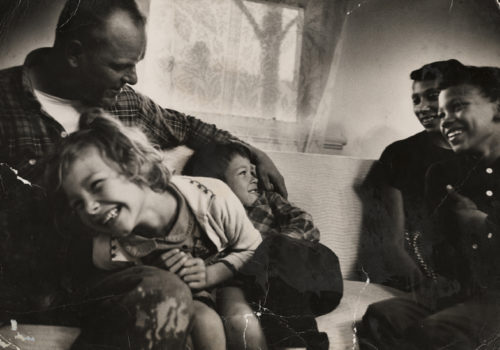He was six-feet-four inches tall, gangly and awkward, all knees and elbows. He wore a suit that was so wrinkled he might have slept in it the night before. As he framed his shots, the ash from his unfiltered Pall Mall dangled dangerously over his Nikon. But his subjects barely noticed. He used a long lens, and watched them – so quietly and so patiently and from such a distance that they always forgot that he was there. That was when the magic began – when Grey Villet captured the people he had come to photograph.
I worked with him as a young reporter for the monthly LIFE – on unforgettable assignments in Beirut, South Africa and Texas. Grey was a veteran by then, and I knew all about his celebrated work for the weekly LIFE – the gritty black-and-white essay about an ambitious executive, “The Lash of Success”; his iconic portraits of that ragtag band of Cubans, led by Fidel Castro, storming into Havana. And yet, until this week, I had never seen (nor even heard about) his extraordinary photographs of Richard and Mildred Loving. That was partly because LIFE – inexplicably – had buried them, running a mere three pages of this remarkable story back in the early 60s. But it was also because Grey was so modest about his work that he simply never mentioned them. Among all the strutting and primping peacocks of his profession, Grey was that rarest of birds: a superb photojournalist who did not need to tell anyone how good he was.
So The Loving Story, opening at New York’s ICP this week is a revelation, an undiscovered gem. In 1958, when Richard and Mildred Loving got married, it was an astonishing act of bravery and defiance: an interracial couple in the era of the Ku Klux Klan and Bull Connor – of firehoses and police dogs and lynchings; the Birmingham bombings and Freedom Rides were still to come. And yet here, in the midst of all the mayhem and hate, are a white man and a black woman casually interwined, so comfortable in their own skin that they are oblivious to onlookers; their armor is their love. Look at the way, at a public drag race in the Deep South, he leans tenderly on her shoulder, as if it were the most natural thing in the world. The compelling thing about the Lovings is that they are exquisitely ordinary. Only a photographer who can make himself invisible could capture that. There was never anything fancy about Grey’s pictures; they stripped people to their essence.
I wonder what the Lovings made of the astonishing fact that Grey was an Afrikaner. He was born in the village of Beaufort West in South Africa, and raised at the dawn of that notorious form of state-sanctioned racism: apartheid. “He never talked about that,” says his widow, the American writer Barbara Villet. (They met in 1961 on assignment for LIFE and became a remarkable photojournalistic team.) When I met him, Grey had been an expatriate for more than 30 years. But as a Capetown teenager, riding his bicycle, Grey saw cops dragging a handcuffed black prisoner up into the station, his head bouncing on the steps. That sparked in Grey a contempt for discrimination and racism in any form – which he expressed with a wicked, sarcastic sense of humor. Decades later, he brilliantly mimicked the die-hard Afrikaners who stubbornly – and worst of all to Grey, stupidly – clung to their prejudices. He was relentlessly honest, dismissive of fascists and bigots: Christopher Hitchens with a camera.
Twenty years after he photographed the Lovings, Grey and I were sent by LIFE to South Africa. It was 1985, during the darkest days of apartheid. Nelson Mandela still languished in a cell on Robbins Island, and the ‘townships’ were in flames. The burning issue to Americans was “disinvestment” – were American companies propping up the racist regime by doing business there? Should they be forced out? And how to tell that story in pictures? We flailed about – and then discovered a 38-year-old black man who seemed to embody many of the contradictions at work in South Africa. By day Sam Mali had an enviable job as foreman of a General Motors plant in Port Elizabeth, supervising a crew that included whites; by night he was a kaffir, required to carry an ID card, banned from areas marked ‘whites only’. He was forced to live with other blacks in a squalid township without power or running water.
Sam Mali was profoundly torn – between his livelihood, and “the struggle.” He felt compelled to attend the funerals of activists killed by the police – but risked his job and his life by doing so; police informers were everywhere. It was an act of courage or madness to allow himself to be photographed for the entire world to see. (And a leap of faith to let down his guard with an Afrikaner, of all people.) And yet Grey, with his self-effacing manner and humanity, quickly put Sam at ease. After a week, they were like old friends.
Grey’s essay on Sam Mali was duly published. When I returned to South Africa a few months later, I was abruptly summoned to the state capitol in Pretoria. There I was confronted by the furious deputy foreign minister of the ruling racist government. Redfaced, he brandished a copy of LIFE – waving it in the air. “These are lies,” he shouted, “and you know they are lies!” I braced myself for the inevitable order of expulsion from the country that was sure to come. But it never did.
Evidently, even the architects of apartheid understood that Grey Villet’s pictures never lied.
Chris Whipple
Chris Whipple is Chief Executive Officer of CCWHIP Productions in New York City. He is Executive Producer of the upcoming PBS series The Gatekeepers, Untold Stories of the White House Chiefs of Staff.
















